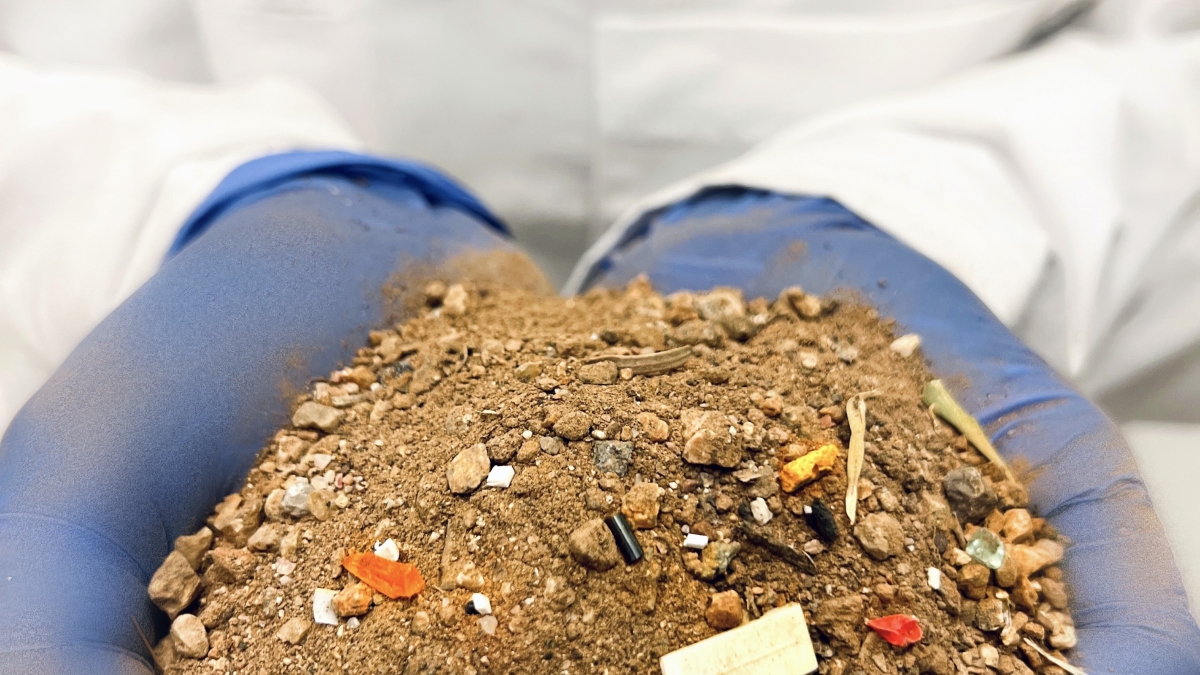Lurking in the sunbaked soil of urban Phoenix is something much more malevolent than scorpions or rattlesnakes — among the dust and rocks, Arizona State University scientists have found systematically higher concentrations of microplastics in 2015 soil samples compared with those of 2005.
Fourth-year doctoral student Kanchana Chandrakanthan, School of Molecular Sciences Professor Pierre Herckes and Professor Matt Fraser, associate director of ASU’s School of Sustainable Engineering and the Built Environment, have just published their findings in the Journal Science of the Total Environment.
Microplastics in general refer to plastic pieces less than 5mm in size. This can include beads, fibers and broken-down plastic fragments. Most attention has been given to the roughly 5 trillion pieces of plastic in our oceans, but terrestrial ecosystems, where most microplastics originate and have the potential to accumulate, typically receive less attention despite the potential physical and toxicological risks they pose to organisms.
“What amazed me the most about our findings was that we saw microplastics in significant numbers in all samples,” Herckes said. “There were no cases with nothing or close to nothing. Also, the lack of clear patterns was unexpected, with some rather remote places having higher concentrations than some of the more urban ones.”
For more than 25 years, the National Science Foundation-funded Central Arizona-Phoenix Long-Term Ecological Research (CAP-LTER) program has been studying urban ecology in the Phoenix metro area from an interdisciplinary, social-ecological perspective.
“CAP has a number of long-term, multi-decadal data sets that are publicly available for use, and with many of our long-term monitoring efforts, we archive samples for future use to answer questions that may have not been conceived when the samples were actually collected,” said Dan Childers, program director and professor at ASU's School of Sustainability.
“An excellent example is our Ecological Survey of Central Arizona (ESCA), where we return to the same (roughly 200) points every five years and sample the sites for a suite of ecological variables,” Childers said.
In this most recent publication, Chandrakanthan and colleagues analyzed ESCA soil samples collected in 2005 and 2015 for microplastics content.
“The work is really all Kanchana Chandrakanthan,” said Herckes, who served as her advisor. “She worked really hard on this very time-consuming and labor-intensive project to extract and isolate the plastics and then count and characterize them. She is a really dedicated graduate student.”
The resulting paper revealed microplastics in all soil samples, and increasing amounts of microplastics in 2015 soil samples compared with 2005. There was no spatial pattern to microplastics deposition, but the size of the microplastics found in local soils appears to be decreasing.
“The issue of plastics pollution and microplastics in the environment is getting increased attention in the press, particularly in relation to the oceans. But little is known about microplastics pollution in arid regions such as the Phoenix metro area,” Childers said.
Chandrakanthan and colleagues also documented atmospheric deposition of microplastics on ASU’s campus for a year, at two-week intervals. They did not find a distinct seasonality to the deposition, but the rates of microplastic deposition they reported for Tempe were on par with those from a number of cities around the world, including cities in Europe, Asia and South America.
Characterization of microplastics in 2005 and 2015 soil samples revealed an array of polymers including polyethylene, polystyrene, polyvinyl chloride, polyacrylate, polyester and polypropylene. A large majority of the microplastics remain chemically unidentified. Weathering of microplastics over time could potentially make them unidentifiable as Chandrakanthan has shown in an earlier study. Polyethylene was dominantly present in a majority of the sampling sites and was the most abundantly identified polymer on average in all soil samples, indicative of the large production of polyethylene on a global scale.
“The data presented in this publication has important implications for both human and environmental health, as attention to the 'over-plasticizing' of our lives, societies and environment grows,” Childers said.
As an interesting aside, Herckes describes an experiment that undergrads in his environmental chemistry laboratory class perform at ASU. They leave a glass or aluminum baking sheet outside and wash it off after two to three days.
“The students are always amazed as to how many microplastics they collect,” Herckes said.
Top photo: Plastics and microplastics in a soil sample. Photo courtesy the School of Molecular Sciences
More Science and technology

ASU professor wins NIH Director’s New Innovator Award for research linking gene function to brain structure
Life experiences alter us in many ways, including how we act and our mental and physical health. What we go through can even change how our genes work, how the instructions coded into our DNA are…

ASU postdoctoral researcher leads initiative to support graduate student mental health
Olivia Davis had firsthand experience with anxiety and OCD before she entered grad school. Then, during the pandemic and as a result of the growing pressures of the graduate school environment, she…

ASU graduate student researching interplay between family dynamics, ADHD
The symptoms of attention deficit hyperactivity disorder (ADHD) — which include daydreaming, making careless mistakes or taking risks, having a hard time resisting temptation, difficulty getting…
